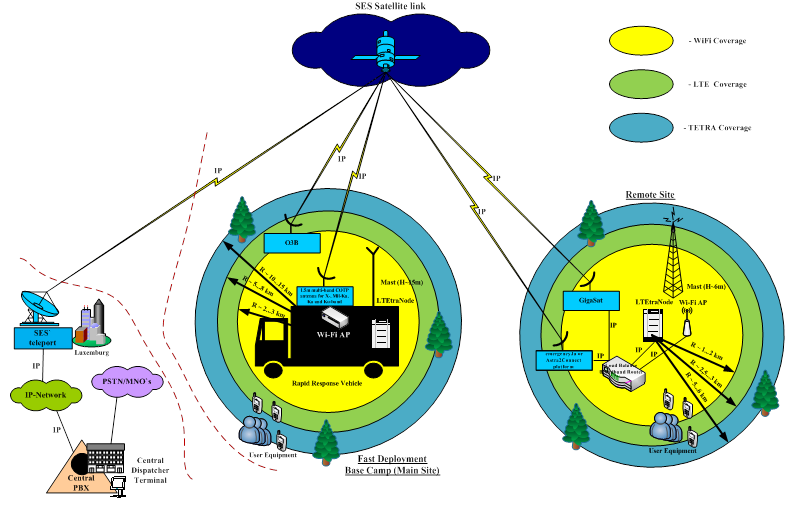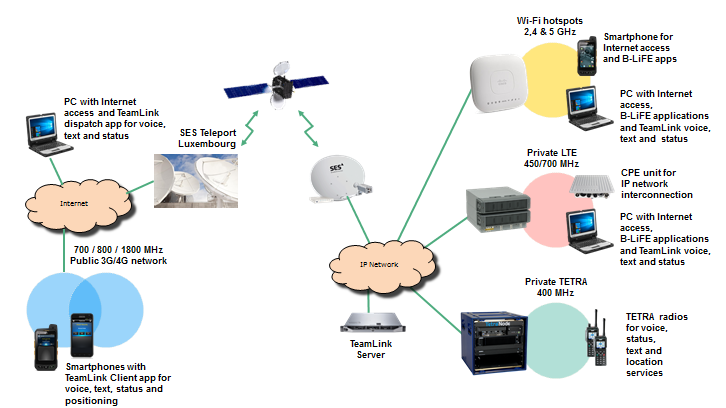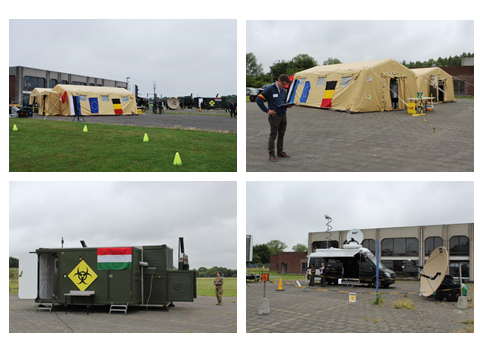
Objectives of the service
The original B-LiFE Demonstration Project has been successfully concluded and B-LiFE is now a sustainable operational service integrated and certified in the European Union Civil Protection Mechanism. Based on the excellent results delivered so far, users have requested to further exploit the promising potentials of the B-LiFE service by extending its capabilities through new telecommunication and crisis management features. This new project phase will therefore enable to develop a new Field Communication and Control System, allowing for increased communication capabilities and new tools for crisis and logistics management. This new service element will be integrated into the current B-LiFE service portfolio.
Users and their needs
Following the request from users for new capabilities to answer their critical needs in terms of emergency response, this new B-LiFE project phase will develop a multi-mission, multi-user Field Communication and Control System, which is integrating satellite telecommunication with terrestrial communications (TETRA, LTE and later 5G).
Based on the experience from the recent terrorist attacks (Zaventem airport, 2016), the Belgian Ministry of Interior (Direction of Civil Security) has developed a partnership with B-LiFE for the development of new telecommunication backup capabilities. The Ministry has selected B-LiFE as a major building block of the envisioned considered service for several reasons:
- Flexible initial backbone architecture allowing the integration of additional modules, such as:
- Multi-platform satellite connectivity
- Full system interoperability and modularity
- Ability to operate in extreme environments
- More comprehensive and faster response to critical user needs
- Operating procedures fully demonstrated
- Fast deployment mechanism compatible with multiple transportation capabilities (air, road, sea)
- Service certified at EU level
These capabilities are now needed on an urgent basis for National Security purposes in many European countries.
Service/ system concept
Institutional and commercial users in Belgium and in all European countries as well as international non-European markets.
The key new features of the extended B-LiFE service include:
- Multimodal satellite telecommunications with O3B option, for missions outside Belgium
- Integration of satellite communications with terrestrial communication networks such as TETRA (TErrestrial Trunked Radio), LTE (Long Term Evolution) mobile network, and later 5G for backup and protection of critical infrastructures, including tunnels. The feasibility of this approach has been already tested with stakeholders at the end of 2017
- Availability of a rapid response vehicles for telecommunication back up with TETRA (ASTRID) interoperability. Vehicles can be rapidly deployed during emergencies and provide back up of terrestrial communications (TETRA, LTE and later 5G) using integrated satellite terminals.
- Real time mapping and monitoring of first responders, equipment and sensor data.
- Assessment of precursor Crisis management and Logistics support tools (e.g. goods tracking, procedure management software).
- Local support and remote training for teams on the field (independent of the domain of expertise).

Generic Architecture of a Fast Deployment Telecommunication Node for Emergencies for a Biological Light Fieldable laboratory.
Space Added Value
The use of three categories of space assets (Satellite communication, Satellite navigation and Earth Observation data) combined with the terrestrial communication networks will provide a high-performance capability in terms of emergency response anywhere in the world.

B-LiFE TEN Proof of Concept deployed during the BioGarden exercise

Views of the Bio-Garden Exercise: B-LiFE tents (above wirh Bio-Laboratory in front and C² at the back), Hungarian Defence Mobile Bio-Laboratory (below left) and SES Networks Rapid Response Vehicle - RRV (below right)
Current Status
A proof of concept in the frame of the “Bio Garden” exercise was demonstrated on 19 June 2018 to run some operational tests of the global system in a real environment with stakeholders. The aim was to collect and consolidate the user requirements for the new features. The feedback from this proof of concept is the basis for the future development, integration, testing and verification work.
The project successfully passed the Critical Design Review (CDR) milestone in January 2019 and the Factory Acceptance Test (FAT) milestone in June 2019.
The final trial of the B-LiFE CCN#2 has been successfully performed in November 2019 at the Belgian Civil Protection facilities in Brasschaat (Belgium) in the frame of a simulated crisis. The B-LiFE Telecommunication Emergency Node has proven its operational capabilities and has allowed B-LiFE to become an even more versatile crisis management tool. The Final Review of the activity took place on 02 March 2020.
Prime Contractor(s)
Subcontractor(s)









